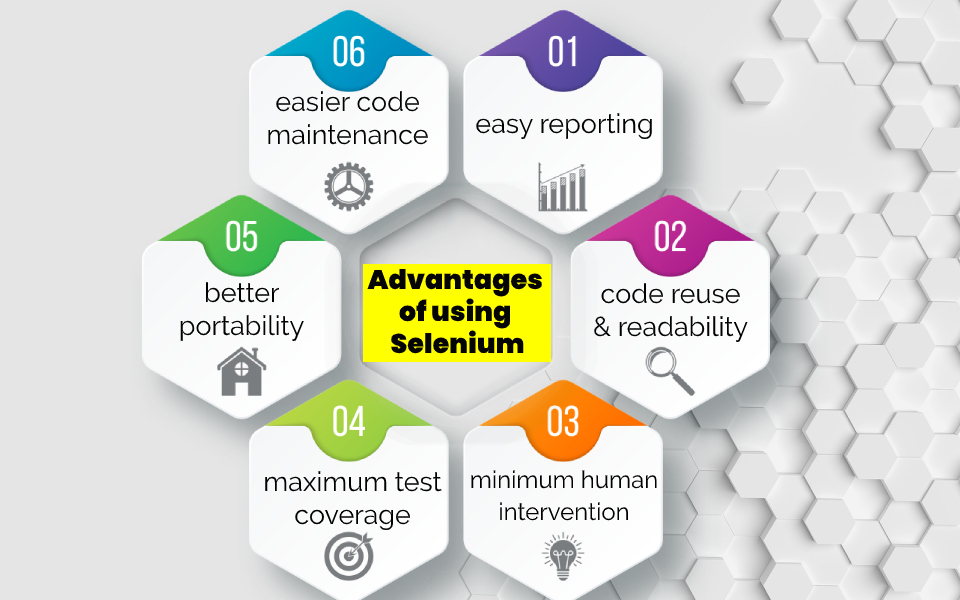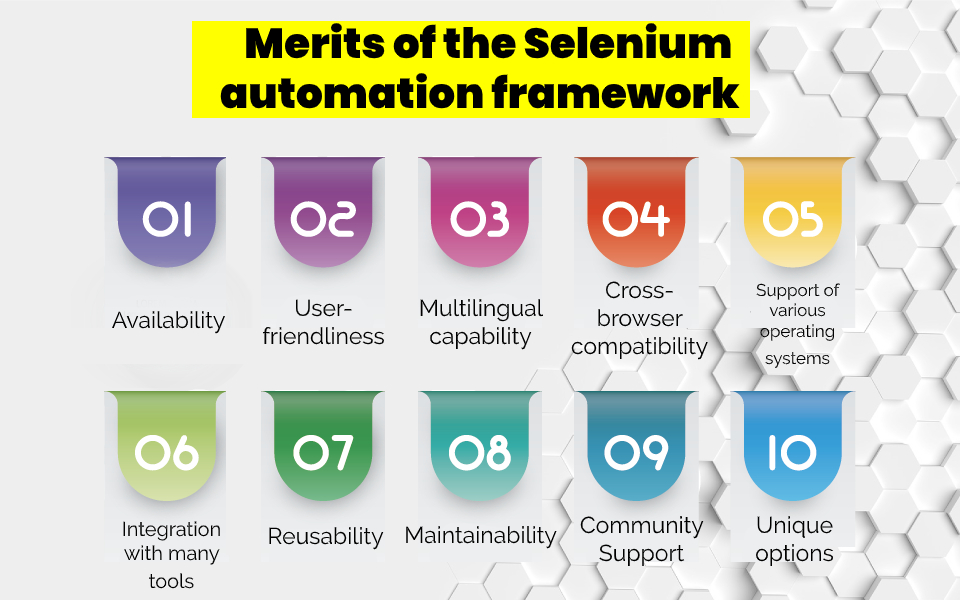7 minutes to read
Complete Guide on How to Build a Maintainable Selenium Framework


Ievgen Ievdokymov
Senior QA Engineer
Selenium is second to none when it comes to automation testing tools. Thousands of automation QA engineers efficiently use it every day to facilitate the execution of testing. If you are a newbie and want to get the philosophy of Selenium, there are some tips on how to get the most out of it and create a maintainable and robust Selenium automation framework.
A brief overview of the Selenium framework
Selenium framework can be defined as a set of testing tools, patterns, and practices that provide opportunities for efficient test automation, code readability, and easy code maintenance.
A plenty of automation framework types are differentiated. Still, if you prefer to work with Selenium, you can build three of them:
Data-driven framework splits test script logic off from test data. It gives an opportunity to store test data in external storage. For this purpose, a QA engineer can use MS Excel Sheets, SQL Database, CSV files, text files, XML files, ODBC sources, etc.
Keyword-driven framework speeds up the process of automated testing. Each set of functions and instructions also stored in an external file has a particular keyword. As a result, QA engineers can easily pick up functions for testing.
As its name implies, a hybrid framework is a combination of two previous frameworks. Either test data or keywords are externalized. While keywords are placed in a segregated Java class file, test data is located in an Excel file or Properties file.
When a great volume of data should undergo testing, a data-driven framework is definitely the best choice. If you are going to deal mostly with functionalities, it is better to apply a keyword-driven framework. In situations when a large volume of either data or functions should be tested, it makes sense to leverage a hybrid framework.
Why Do We Need A Selenium Framework?

Selenium framework considerably simplifies the work of automation QA engineers. Code and data would be kept together without a framework, and it would heavily affect reusability and readability. When it is properly developed and implemented, the Selenium framework brings multiple advantages such as code reuse and readability, better portability, easier code maintenance, minimum human intervention during test running, maximum test coverage, easy reporting, and many others.
Merits of the Selenium automation framework

Numerous merits make the Selenium automation framework so popular among QA experts from different corners of the world. Let's have a look at its main advantages to understand why it is an unbeatable automation testing tool:
Availability
Selenium is freely available, and everyone can use it without paying a penny whereas most other solutions are commercial.
Most user actions can be reproduced
Selenium WebDriver can copy the most various user actions. Therefore, QA engineers can automate various inputs like dragging and dropping, mouse-clicking, button pressing, clicking and holding, etc.
User-friendliness
Selenium automation framework is easily implemented and easy-to-use. Its interface is pretty simple as well. Besides, QA experts can enrich their frameworks with different extensions according to their needs and project requirements.
The most various scenarios can be covered
Selenium provides various options; that is why every QA expert most likely finds something that suits their scenario.
Multilingual capability
It is indeed a helpful feature of Selenium. QA experts enjoy freedom while choosing a programming language. Building the Selenium automation framework they can use Java, C#, JavaScript, Python, Ruby, Perl, or PHP.
Cross-browser compatibility
Selenium supports all commonly used browsers — Safari, Chrome, Opera, Firefox, Edge, Internet Explorer.
Support of various operating systems
Selenium supports such OSs as Windows, Linux, Mac, UNIX, etc.
Integration with numerous tools
To significantly simplify automated testing, Selenium smoothly integrates with numerous tools. For instance, integration with TestNG & JUnit enables test case management and report generation. Integration with Maven, Jenkins, and Docker gives an opportunity for deployment process automation.
Reusability
Created scripts are compatible with different browsers. As a result, QA engineers can run numerous testing scenarios utilizing the same base.
Maintainability
QA experts can quickly modify code and easily maintain scripts due to an opportunity to refactor and group their test cases.
Community Support
The Selenium community is indeed wide and active. As a result, a ton of information can be found, and valuable pieces of advice can be received when QA experts need them.
Unique options
With Selenium WebDriver, QA experts can reproduce clicking on the browser "back" and "forward" buttons. This feature can be pretty useful in some situations and most other solutions do not offer it.
How to build maintainable Selenium framework

A maintainable and reliable test automation framework is 50% of test automation success as it enables QA experts to create effective test scripts. Below you can find some aspects you should take into consideration to build a robust Selenium automation framework.
To create a framework that would satisfy all your needs, it is vital to identify processes that should be automated. That is why you should study the internal structure and workflows of your application to understand which processes can be and must be automated and define requirements for your future test automation framework.
Programming language
As we have already mentioned, Selenium supports plenty of programming languages and you should decide which one to use for your framework design. In this case, we advise you consider a language that has been used for your application development or a language at which most of your colleagues are good.
Framework architecture
Selenium framework architecture consists of the Selenium Core component and the Selenium Test component. It is advised to begin with the Selenium Core component which controls browser instances and element interactions. As soon as your Selenium Core component is ready, you can proceed to the Selenium Test component. You can use a page object model (POM) to design this component. It is indeed very useful due to its ability to eliminate code redundancy and cut down testing expenses.
Unit framework
Unit framework is utilized for test verification and test case grouping and prioritization. Working on your automation framework development you should choose a unit framework that will be integrated. In these terms, TestNG is considered as one of the best unit frameworks for Selenium as it offers multiple benefits, among which are such valuable features as parameterizing, sequencing, annotations, and grouping.
CI/CD implementation
To get the most out of your automation framework you should also consider CI/CD implementation. In these terms, a range of helpful tools should be integrated with your framework:
Dependency managers like Maven, NuGet, Gradle, NPM, and Ant make it easier to manage dependencies and libraries. Build tools are also useful for writing source code, creating dependent libraries, and running tests.
Version control systems as GitHub, Bitbucket, or TFS significantly simplify work on the source code of your tests. Still, if your source code should be kept private, it is highly advised to implement your own version control system using Git.
To speed up product delivery and get a competitive advantage, it is essential to integrate automated tests into CI/CD pipelines. That is why, integration with one of the CI tools such as Jenkins, TFS, or Bamboo is a must.
Report generation
A reliable test automation framework should also provide test results generating accurate testing reports. These reports should be clear, readable, and available for either technical or non-technical staff who need them. As Selenium does not provide a built-in report option, you should integrate an external tool. For instance, you can utilize TestNG or JUnit. However, reports generated by these tools are not readable. To create human-readable reports, external libraries like ExtentReport or Allure should be used.
Conclusion
Test automation can significantly simplify and optimize testing processes. However, to achieve excellent results, it is essential to prepare a strong foundation, i.e., create an effective test automation framework. In these terms, Selenium is the best choice. It provides almost everything you need, while options that are not available still can be used due to integration with multiple tools. While building your Selenium automation framework, you should take into consideration numerous aspects as project requirements, processes that should be automated, programming language, framework architecture, unit framework, report generation, CI/CD implementation, etc. Still, at the end of the day, all efforts will be justified because a well-thought framework enables QA team members to create effective automated scripts and maintain them easily.
